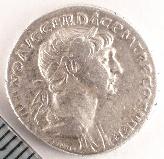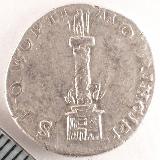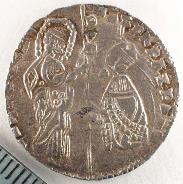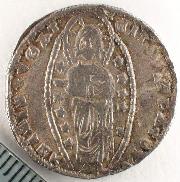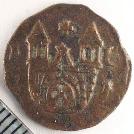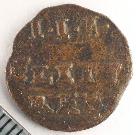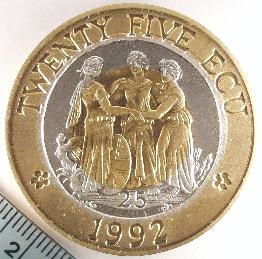Chatter
archive
also available
| Chicago Coin Club |
|---|
| Volume 49 No. 6 |
June 2003 |
|---|
Editor's Notes
Sorry about placing the wrong month on the cover of the previous Chatter;
and for a few other typos scattered inside.
This is the real June issue.
Here are three timely reminders:
First, please consider submitting a trip/show report to the Chatter,
for any numismatic show, lecture, or event you attend.
Second, Carl Wolf maintains some email lists for club members;
you could sign up for just the major or urgent announcements,
or you could get everything, including requests for assistance that
the club receives.
E-mail Carl at carlwolfco@msn.com to find out more.
Lastly, please remember that three recent years of the Chatter
are available at our web site at
www.ChicagoCoinClub.org/chatter/
and that synopses of future programs also are available on
the club's main web page.
The details about Mark Borckardt's talk at our 11am Saturday meeting
at the MidAmerica Coin Expo will be added to our web page as they
become known.
Paul Hybert, editor
Minutes of the 1012th Meeting
President Mark Wieclaw called the 1012th meeting
of the Chicago Coin Club to order on April 9, 2003 at
7:03PM. The meeting was held at 1 Bank One Plaza.
The minutes for February and March were approved.
The Treasurer reported that we have a total of 7014.95 in various accounts.
There was one guest present: Curtis Clay.
First Vice-President Bob Feiler introduced
the speaker for the evening John Wright.
The topic was 300 Years of Portraits of the Caesars as Shown on Sestertii Coinage.
First Vice-President Bob Feiler thanked John for his lecture
and presented him with the CCC speakers
medal and an ANA educational award.
There were nine participants in the evening's show and tell. They presented as follows:
-
Bob Weinstein - Chicago merchant tokens
-
Mike Metras - Pop out half dollar
-
Sharon Blocker - World paper money, 1979 ECU
-
Bob Leonard - Roman sestertii
-
Don Dool - Provincial notes from Argentina,
2 Caracas revolutionary quarter real,
coins of the Dutch Indies
-
Mark Wieclaw - Uncut sheet of cloth notgeld notes,
several cloth notgeld notes,
Roman aureus of Tiberius,
Byzantine nomisma of Romanus IV
-
Steve Huber - 1887 gold proofs from England
-
Carl Wolf - Pig mouth money from Thailand
-
Bob Fieler - Token copying a fugio cent, composite coins
Reading of Applications for Membership:
There was 1 reading for membership, the 2nd reading for Louis Jordan
Old Business:
Bob Leonard showed the prototype for the CICF give-a-way.
Number 46 of the CPMX give-a-way was presented to the archives.
Bob Feiler said that research is underway for the banquet location.
New Business:
Bob Fieler announced that Bruno Rzepka has donated materials for the archive.
Phil Carrigan suggested that what is not needed be sold at the club auction.
Motion approved for $25 donation to the ANA fund for the Davenport Collection.
Motion approved for educational program featuring a US topic
in conjunction with the Mid-America Show.
Meeting recessed at 9:08 PM
President Mark Wieclaw reconvened the 1012th meeting
of the Chicago Coin Club on April 26, 2003 at 1:00PM.
The meeting was held at the Holiday Inn O'Hare in conjunction with the CICF.
There were 57 attendees 25 of whom were guests.
First Vice-President Bob Feiler called for membership applications
and discussed future programs.
First Vice-President Bob Feiler introduced the speaker
for the afternoon, J. Graham Esler.
The topic was The Canadian Silver Nuisance, 1865-1870.
First Vice-President Bob Feiler thanked Mr. Esler for his lecture and presented him with the CCC speakers
medal and an ANA educational award.
Reading of Applications for Membership:
There was 1 reading for membership: the 1st reading for Herbert Schmidt.
Give-a-way:
Carl Wolf presented give-a-way #1 to the archives,
#2 to the featured speaker, and #3 to the author, Bob Leonard.
Give-a-way distributed to attendees.
Member Recognition:
Recognition was given to two members who have recently had books published.
Robert Leonard has authored a reference on California Fractional Gold.
Saul Needleman has authored a book on the use of the name Jehovah on Coins and Medals.
Meeting adjourned at 1:50 PM
Respectfully submitted by Bob Weinstein
Minutes of the 1013th Meeting
President Mark Wieclaw called the 1013th meeting
of the Chicago Coin Club to order on May 14, 2003 at 7:00PM.
The meeting was held at 1 Bank One Plaza.
The minutes for April were not received in time for publication.
There were three guests present: Chuck Jacobs, Ewa Tokarski, Matyga Ianina.
First Vice-President Bob Feiler introduced the speaker for the evening Cliff Mishler.
The topic was Fifty Years of Perspectives on Numismatics.
First Vice-President Bob Feiler thanked Cliff for his lecture
and presented him with the CCC speakers
medal and an ANA educational award.
There were eight participants in the evening's show and tell. They presented as follows:
-
Carl Wolf - Pack saddle sycee
-
Mark Wieclaw - Uncut sheet of cloth notgeld,
10,000 and 5000 mark cloth notgeld notes,
Roman cast bronze semis and tremis, denarius of Trajan.
-
Bob Leonard - Ducat of Venice and two imitations of same.
-
Don Dool - copper coins of Germany, Italy and Catalonia; Buenos Aires subway tokens.
-
Sharon Blocker- 9 dollars of Bermuda, coins of Poland, EU, and Somalia.
-
Lyle Daly - Copy of new US $20, type set of US Notes
-
Bob Fieler - Painted Mexican coins.
-
Bob Weinstein -Ancient Indian coins
Reading of Applications for Membership:
There were 4 readings for membership: the2nd reading for Herbert Schmidt,
and 1st readings for Chuck Jacobs, Ewa Tokarski, Matyga Ianina.
Old Business:
Bob Feiler discussed options for the banquet.
Carl Wolf discussed ways to improve article writing.
New Business:
Lyle Daly asked about possibly getting together in a less formal atmosphere
to discuss numismatic topics.
Steve Zitowsky suggested the possibility of having
a less structured meeting to achieve this.
Meeting adjourned 9:10 PM
Respectfully submitted by Bob Weinstein
Speaker's Wor[l]d
Fifty Years of Perspectives on Numismatics
Presented by
Clifford Mishler
to our May 14, 2003 meeting.
When Cliff was ten years old, a friend showed his collections
of used U.S. and world-wide stamps,
trying to interest Cliff in the hobby.
Cliff would have none of it, however;
the more the friend and the friend's mother tried,
the more resistant Cliff became.
Not even Linn's Stamp News could get his interest
- until he saw a small ad from the Tatum Coin Co.,
offering approvals and ten pieces of WWII currency for only ten cents!
He bought three of the first five or six coins sent on approval:
a silver 3-cent piece for $2, a now-forgotten piece,
and a 1 pice of Zanzibar dated 1299 ("Gee, that is old," was
his first thought).
Those early pieces caught his attention,
and started his scrounging for information.
His growing interest in coins was not broken when he found
that year 1299 in the Moslem calendar corresponds to 1882AD;
nor has that coin's virtually unchanged value
50 years later in Krause diminished his interest.
A recurring theme of Cliff's talk was,
"Something very simple can have a big impact."
A review of his examples shows it is no use trying to predict what might
be the next big thing.
Act upon your idea to fill a niche, and be very
satisfied and surprised if it turns into "the next big thing."
As a new collector in 1950, his first sources of information were ANA's
The Numismatist
and Lee Hewitt's
Numismatic Scrapbook.
A selection of regional (club) publications was the other source available then,
so he joined many clubs to obtain more information.
At that time, coin collecting had been growing in popularity for some decades,
thanks to two major developments:
coin boards, and B. Max Mehl's advertisements.
Throughout the 1920s and 1930s, Mehl's advertisements
in the Sunday supplements of newspapers around the country
raised awareness of coin collecting,
even though no one ever took him up on his offer to buy a 1913 Liberty nickel.
One of the ways he put information into people's hands was
with his Star Rare Coin Encyclopedia which he sold for 10 or 15 cents each.
Even today, estate sales with a small coin hoard
sometimes are found with a copy of the enclopedia.
The first coin board was produced by J.K. Post of Neenah, Wisconsin,
and Whitman Publishing produced many of them starting in the 1930s.
Lee Hewitt acknowledged that as the primary stimulus for collecting U.S. coins.
Even after some decades of growth the hobby still was limited,
with few dealers and with few clubs outside of urban areas.
Grading was a personal endeavor,
and no S-mint coins were on the East Coast.
The 1950s and 1960s were the heydey of clubs;
not just coin clubs, but all sorts of clubs;
people joined and participated, even if just for the social aspects.
The creation of clubs was one solution to the problems of
not much reliable information, and not much communication.
Clubs sponsored most shows - commercial shows were a no-no.
In 1952, coin collector Chet Krause started
Numismatic News
in Iola, Wisconsin.
With no contact with local collectors,
Chet went looking for a communication medium;
not finding one, he started one.
At that time, the Wayte Raymond catalogs were venerable
and the Red and Blue Books were the new kids on the block.
At Whitman, Dick Yeoman said one pricipal,
"Don't worry over something you have no control."
To give us an idea of how the times have changed,
Cliff mentioned that, at one point in the 1950s,
everything that he could find on coin collecting
would occupy less than three feet of shelf space;
now, Krause Publications has 5 magazines, 50 book titles, and 3 shows
just for numismatics.
Coin World started in the 1960s,
and Cliff told how he and Margo Russell were the only
members of the numismatic press among the 40-50
media people invited by the Treasury to view the gold through peep holes
on the one day when the Treasury Department opened Ft. Knox,
the nation's gold repository.
Other events in the 1960s and 1970s were the removal of silver coinage,
the start of the "clad" coinage that continues today,
and the legalization of private gold ownership.
Cliff recounted how Krause's promotion of a then-new Kennedy half dollar
and a six-month subscription resulted in 30,000 new orders;
but since banks gave only two Kennedy Halves to each customer,
it took 3 to 4 weeks of scrambling to satisfy most subscribers.
Cliff then spent some time explaining how the mint marks came to be removed
from U.S. coins,
and how Representative Annunzio of Illinois and Senator Sparkman of Alabama
helped restore those mint marks.
1972 saw the first edition of Krause's
Standard Catalog of World Coins,
with a first printing of 10,000 copies.
As this "Redbook for foreign coins" was intended as a leadin for their
new magazine on foreign coins,
a post card was included in each copy and the books' buyers were
encouraged to send in their names and addresses.
After two more printings resulted in 30,000 copies sold in 18 months,
Krause had a list of about 25,000 collectors;
just in time for the introduction of
World Coin News
in 1974 with 20,000 subscribers.
In order not to introduce a new numbering scheme,
the catalog used Yeoman numbering with permission of Whitman.
The push in 1973 and 1974 for U.S. bicentennial coins
started with just a dollar and half dollar planned,
but fortunately a quarter dollar was added as that was
the only coin to circulate widely; they turn up in change even today.
The 1980s started with the boom & bust in gold and silver;
1982 saw the resumption of commemmorative U.S. coins,
and the program continues today in spite of some abuses and criticisms.
The 1987 coinage redesign push yielded no immediate changes,
but the current state quarter program and the nickel program
might be among its residual effects.
Looking ahead, Cliff sees a bright but specialized future for the hobby.
Much more information tomorrow will lead to more satisfaction with the hobby,
and the specialization trend will continue;
collecting by date was popular in the 1800s,
by date and mintmark in the 1900s,
and by varieties within a type today.
New collectors might start not with Lincoln cents,
but possibly go directly to Standing liberty Quarters;
that is partly due to the increased cost to get involved in the hobby today,
and due to the fewer number of young people who collect coins.
He feels that young people should be encouraged to collect something,
anything,
because someone introduced to collecting as a youngster
is likely to collect something as an adult;
the larger the collecting universe,
the better we all are.
However, there are some changes that go along with this future.
Although a wide knowledge base now is beneficial and desired,
the specialized collector might never venture outside that one realm.
Although the on-line resources (chat rooms, eBay, etc.)
have diminished the classified ads in numismatic magazines,
the editorial presentation needs to be strengthened
to make up for the shrinking trader aspect.
Cliff mentioned the two major traits used to help select the newest editor at Krause:
be a collector (of something, to know that mindset),
and be from a small-town newspaper
because the hobby community, although geographically wide spread,
is best viewed as a small social community.
To answer a member's question of why the 2002 catalog does not list all
coins from 1999 through 2001,
Cliff admitted that obtaining information is a challenge,
as sources might not keep up with the latest material;
he also mentioned that for 110 mints, it is easy to get information from 90,
some effort is needed to find out everything from the next 10,
and that working with the last 10 uses up most of the time.
Cliff used a question about a second edition (not a reprint of the first edition)
of Haxby to illustrate a fact of writing a book:
ten years were spent working on the first edition;
with only six years spent so far on the second edition,
he is not sure if/when the second edition will appear.
Citing his lack of expertise with CDs and the Internet environment,
Cliff declined to comment on how they might be used to address
some of the publshing challenges mentioned above.
He gave no timelines or promises,
but he expressed confidence in the new Krause leaders
who were picked for their knowledge of the new technologies.
Show and Tell
Each image has a scale in the lower-left corner,
with the tics spaced 1 mm apart.
Because the brightness and contrast were manipulated on a computer,
the coloring of a coin's image differs from the coin's actual coloring.
-
Carl Wolf
reached a milestone with his fiftieth exhibit of framed primitive money.
Pack Frame Sycee from the Yunan province of China
is a large silver piece which facilitated trade with Siam and Burma.
This one was worth 5 taels, or 5,000 brass cash coins.
-
Mark Wieclaw
concluded his run of uncut sheets of linen notgeld,
but continued his ancient coin theme.
-
An uncut sheet of twelve notes, 12,000 marks each,
from Bielefeld and dated 1923.
Mark also showed a single 5,000 mark note on burlap.
-
One of Mark's interests is Pegasus on ancient coins .
A cast bronze semis (280 - 245BC) shows Pegasus on both sides.
-
A tremis of 245 - 225BC has a head of Mars with four dots under the bust
on the obverse, and a ship's prow and four pellets on the reverse.
-
A denarius of Trajan;
the reverse shows Trajan's column.
-
Bob Leonard
started by showing the new edition of
California Pioneer Fractional Gold
he co-authored.
Then he showed a Venetian ducat of Andrea Laredo (1344-54)
and two contemporary imitations:
-
A good ducat of 98 or 99% gold,
having good color.
-
An imitation from an eastern Mediterranean mint,
having a K instead of R on the obverse,
and a K on the reverse where none appears on the original.
Although of a paler gold, the weight is good
due to its thicker and slightly larger size.
-
The newest addition to Bob's collection is an even paler electrum,
thicker and even larger.
this piece also has the K,
making Bob wonder if it were a mint mark.
This piece is similar to a hoard published in a Belgian journal (1979?).
The fineness varied from 44 to 91% but the weights were the same,
leading to the thought that they passed by count or weight.
This piece is probably from a Turkish mint in western Anatolia.
-
Don Dool
showed some copper coins acquired from CICF:
-
Hameln (Hamlin), 1621, III Flitter.
Best know from the children's tale of the Pied Piper of Hamlin.
Coinage privilege was purchased in the 13th
century from the Bishopric of St. Boniface.
Obverse has the church of the Bishopric with the arms of the city,
a millstone, in the doorway.
-
Mantua, 1661, Soldo.
Bust of Charles II, 1637-1665.
This is the only copper coin of this King.
Although most 17th century copper coins of Mantua are undated,
this one has the date on the reverse.
-
Tarrega, 1641, Seisino.
During the French occupation of the Province of Catalonia (1641-1652),
cities and towns in the province struck copper coins;
there are 20 listed in Eklund,
and Krause lists two additional ones.
All locations except Barcelona are listed as rare to extremely rare by Eklund;
Don now has six of the locations.
-
Don concluded with a notebook presented to him during his recent trip to Argentina;
it contains a Buenos Aires subway collection with tokens, tickets, photos, etc.
-
Sharon Blocker
found pieces in four of her collecting areas at CICF:
-
A triangular shaped $9 Bermuda coin.
-
The inclusion of gem stones and such,
as well as the use of unusual materials.
A 10 zloty coin from Poland has amber for a football,
another coin using a crystal as a star,
and a piece made of percelain.
-
In bi-metallics,
this three-piece uniface 25 ecu.
-
And for animals on coins,
a one ounce silver from Somalia featuring two chimps.
-
Lyle Daly
started by passing around a color image he printed two days earlier
of the new U.S. $20 bill, from a web site.
It looked pretty good.
Then he showed the nine pieces he has
out of the ten needed for a U.S. currency type set:
-
1928, $1, $2, and $5.
Large denomination and large seal.
-
1928, $2 (missing the $5).
Text (about not good foe public debt) over seal now dropped.
-
1953, $2 and $5.
Seal has moved to the right of the portrait,
and over a smaller denomination.
-
1963, $2 and $5.
In God We Trust added on reverse.
-
1966, $100.
-
Bob Feiler
also showed some acquisitions from the recent CICF.
A group of hand painted scenes on obsolete Mexican coins caught his eye.
The wife of a dealer would buy one from a street artist
on every trip to Mexico City.
Bob bought a few of the pieces,
which do not have one side ground smooth before painting
as did some pieces he has shown in the past.
-
Bob Weinstein
showed ancient coins from widely separate areas:
-
Coins of the Scythian kings who ruled areas around the Black Sea
during the 3rd and 2nd centuries BC.
These were made by the local Greeks who then gave them to the Scythians as tribute.
-
A corroded lead coin from 3rd century BC,
from recent excavations in the southwest corner of Sri Lanka.
-
A small silver coin from the Indian state of Vigianagar;
the design features a lion, but the head is off of the coin.
Silver coins were not often issued by them,
and lead is a major impurity of this piece;
maybe this was made from the byproducts of refining
the gold typically used in their coinage.
Our 1014th Meeting
| Date: | June 11, 2003 First session |
| Time: | 7:00 PM |
| Location: | Downtown Chicago.
Please remember the security measures at our meeting building:
give a club officer the names of all your guests prior to the meeting day;
and everyone must show their photo-ID at the security desk. |
| Featured speaker: |
Steve Feller - Newly Discovered Facts about Confederate Coinage |
|
For years numismatists thought they knew everything
there was to know about Confederate coinage.
But over the last decade new records have revealed that
the Confederate government was in possession of dies
and were striking U.S. coins.
Feller has been a student of this coinage for many years
and will tell this interesting story.
|
| |
| Date: | June 28, 2003 Second session |
| Time: | 11:00 AM |
| Location: | at the MidAmerica Coin Expo,
which is held at the Donald E. Stephens Convention Center, 5555 North River Road, Rosemont, IL.
No admission charge for our meeting. |
| Featured speaker: | Mark Borckardt, V.P. at Bowers & Merena Galleries
- First Issues of the U.S. Mint |
|
Mark is a leading authority on the issues of the first U.S. Mint
and has served as an instructor at the ANA Summer Seminars.
Look to our web site, www.ChicagoCoinclub.org/ for a
more detailed description of this talk.
Catch this talk just days before he teaches a one-week course
in this area at ANA headquarters in Colorado Springs.
|
Important Dates
|
Our June meeting will consist of two sessions:
we will end the first session with a recess (instead of an adjournment),
and we will reconvene for the second session at the MidAmerica Show. |
| June |
11 |
CCC Meeting - Featured Speaker - Steve Feller on Newly Discovered Facts about Confederate Coinage |
| June |
27-29 |
22nd Annual MidAmerica Coin Expo
at the Donald E. Stephens Convention Center, 5555 North River Road, Rosemont, IL.
Admission for Friday and Saturday is $5; free admission on Sunday. |
| June |
28 |
CCC Meeting - 11am at the MidAmerica Coin Expo,
which is held at the Donald E. Stephens Convention Center, 5555 North River Road, Rosemont, IL.
No admission charge for our meeting.
Featured Speaker - Mark Borckardt, V.P. at Bowers & Merena Galleries on
First Issues of the U.S. Mint |
| |
| July |
9 |
CCC Meeting - Featured Speaker - Don Dool on Numismatic Finds of San Martin |
| |
| August |
13 |
CCC Meeting - Featured Speaker - Mike Metras on Early Trains on Obsolete Currency |
| |
| September |
10 |
CCC Meeting - Featured Speaker - Richard Hamilton on Stock Certicicates from Illinois Railroads |
| |
| October |
8 |
CCC Meeting - Featured Speaker - Robert Weinstein on Indo-Sasanian Coinage |
Birthday and Year Joined
| July |
4 |
Chester Poderski |
| July |
12 |
Flemming Lyngbeck Hansen |
2000 |
| July |
13 |
Gerard Anaszewicz |
1981 |
| July |
19 |
Terry L. Capps |
1996 |
| July |
19 |
John R. Connolly |
1997 |
| July |
19 |
Richard S. Hamilton |
1986 |
| July |
20 |
Kermit W. Wasmer |
1997 |
| July |
27 |
David Simpson |
1980 |
Chatter Matter
All correspondence pertaining to Club matters
should be addressed to the Secretary and mailed to:
CHICAGO COIN CLUB
P.O. Box 2301
CHICAGO, IL 60690
Visit Our Web Site
http://www.ChicagoCoinClub.org/
Contacting Your Editor
| Paul R. Hybert
|
| prhybert@worldnet.att.net |
Club Officers
| Mark Wieclaw | - President |
| Robert Feiler | - First Vice President |
| Jeff Rosinia | - Second Vice President |
| |
| Directors: | Lyle Daly
Mike Metras
Steve Zitowsky
Carl Wolf |
| |
| Other positions held are: |
| Robert Weinstein | - Secretary |
| Steve Zitowsky | - Treasurer |
| Paul Hybert | - Chatter Editor |
| Phil Carrigan | - Archivist |
